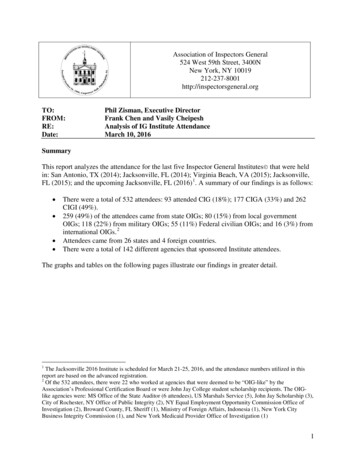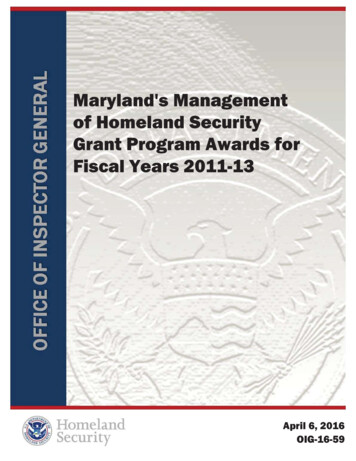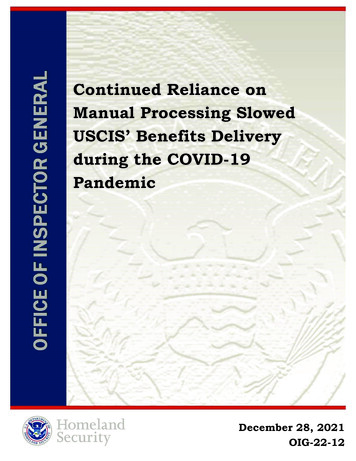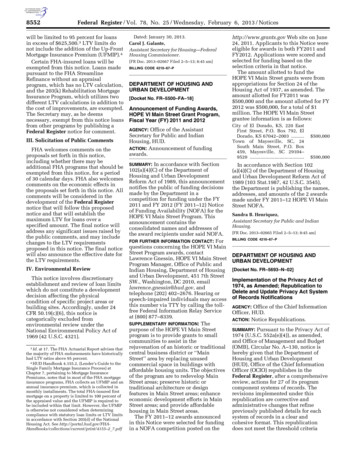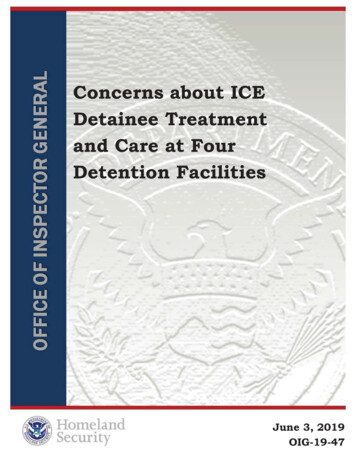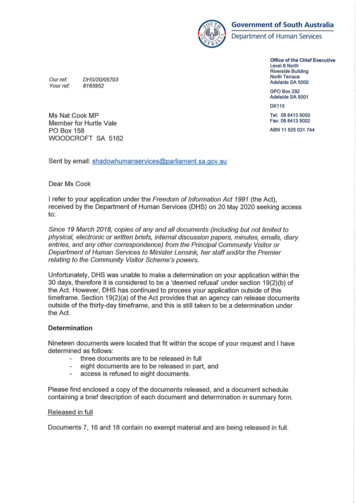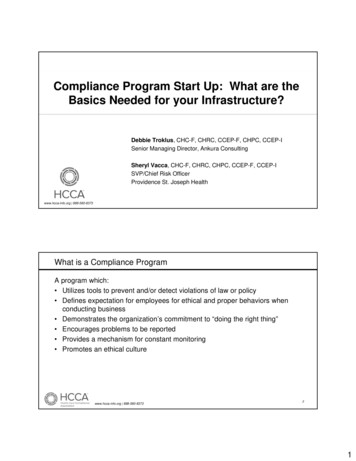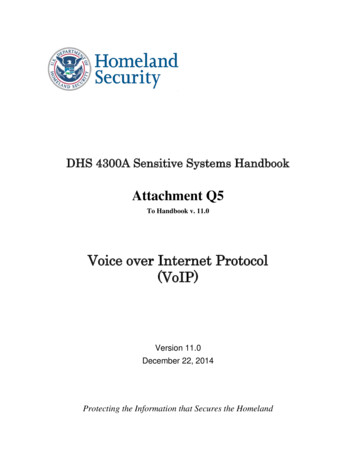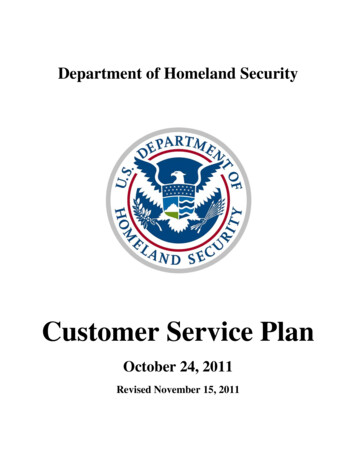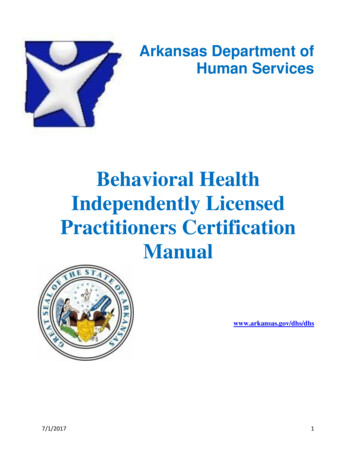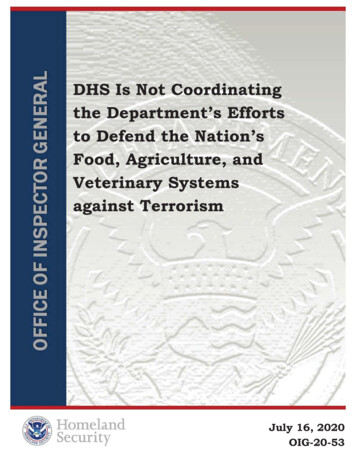
Transcription
DHS Is Not Coordinatingthe Department’s Effortsto Defend the Nation’sFood, Agriculture, andVeterinary Systemsagainst TerrorismJuly 16, 2020OIG-20-53
-XO\
DHS OIG HIGHLIGHTSDHS Is Not Coordinating the Department’sEfforts to Defend the Nation’s Food, Agriculture,and Veterinary Systems against TerrorismJuly 16, 2020Why We DidThis AuditWe conducted this audit todetermine whether DHS’CWMD Office implemented aprogram to coordinate theDepartment’s efforts todefend food, agriculture, andveterinary systems againstterrorism and other highconsequence events in theUnited States as required bySAFA.What WeRecommendWe made threerecommendations to DHS’CWMD Office to improveoversight, policy initiatives,and coordination of theDepartment’s efforts toprotect the Nation’s food,agriculture, and veterinarysystems.For Further Information:Contact our Office of Public Affairs at(202) 981-6000, or email us hs.govWhat We FoundThe Securing Our Agriculture and Food Act (SAFA) requiresthat DHS’ Countering Weapons of Mass DestructionOffice (CWMD) carry out a program to coordinate theDepartment’s efforts to defend the country’s food,agriculture, and veterinary systems against terrorism andother high-consequence events. According to SAFA, theprogram should provide oversight, lead policy initiatives,and coordinate with DHS components and Federalagencies. However, CWMD has not yet carried out aprogram to meet SAFA’s requirements.This occurred because CWMD believes it does not haveclearly defined authority from the Secretary to carry outthe requirements of SAFA. In addition, since itsestablishment in December 2017, CWMD has notprioritized SAFA requirements but instead has focused itsresources on other mission areas. As a result, CWMDhas limited awareness of DHS’ ongoing efforts and cannotensure it is adequately prepared to respond to a terroristattack against the Nation’s food, agriculture, or veterinarysystems.CWMD ResponseCWMD concurred with all three recommendations andprovided corrective action plans to address therecommendations. However, CWMD noted that since ouraudit fieldwork, it has undergone a change in seniorleadership that reprioritized the critical role CWMD playsin implementing SAFA. Specifically, CWMD reconstituteda formal Food, Agriculture, and Veterinary Defenseprogram, which is now staffed with personnel supportedby a budget. CWMD is also rebuilding and strengtheningrelationships with internal DHS components andinteragency and external stakeholders.OIG-20-53
OFFICE OF INSPECTOR GENERALDepartment of Homeland SecurityBackgroundThe United States’ food, agriculture, and veterinary systems are vulnerable tothreats of terrorism and other events that pose a high risk to homelandsecurity such as natural and unintentional introduction of diseases, pests, orpoisons. For example, evidence suggests terrorists have considered targetingpeople by adding toxic chemicals and pathogens1 directly to the food supply.To illustrate, following the September 11, 2001 terrorist attacks, the U.S.military found a list of pathogens in an Afghanistan cave that Al-Qaedaplanned to use as potential biological weapons to target humans and the foodsupply.Homeland Security Presidential Directive-7: Critical Infrastructure Identification,Prioritization, and Protection designated food and agriculture as one of theNation’s critical infrastructure sectors, so vital to the United States that itsincapacitation or destruction would have a debilitating effect on security,national economic security, national public health, or safety. Within theDepartment of Homeland Security, six components help protect the Nation’sfood, agriculture, and veterinary systems: U.S. Customs and Border Protection(CBP), Federal Emergency Management Agency (FEMA), Science andTechnology Directorate, Cybersecurity and Infrastructure Security Agency(CISA), Countering Weapons of Mass Destruction Office (CWMD), and Office ofIntelligence and Analysis. For example, CBP protects the United States fromthe threat of invasive plant pests and foreign animal diseases through anapproach designed to prevent prohibited agricultural items from entering thecountry. FEMA conducts interagency exercises to respond to disasters,including large-scale agricultural or food incidents. In addition, among otheractivities, CISA manages a web-based platform for information sharing relatedto food, agriculture, and veterinary efforts.In 2017, the President signed into law the Securing Our Agriculture and FoodAct2 (SAFA) requiring the Assistant Secretary for DHS’ Office of Health Affairs(OHA) to implement a program to carry out the Department’s efforts to defendfood, agriculture, and veterinary systems against terrorism and other eventsthat pose a high risk to homeland security. SAFA specifically required theprogram to provide oversight, lead policy initiatives, and coordinate with DHScomponents and Federal agencies that help support this mission. OHA’s Food,Agriculture, and Veterinary Defense Branch, which was led by three veterinarymedical officers and epidemiologists, became responsible for coordinating theDepartment’s activities and fulfilling the requirements of SAFA. In December2017, the Department moved all components with chemical, biological,radiological, and nuclear functions, including relevant portions of OHA, underA pathogen is a specific causative agent (such as a bacterium or virus) of disease.On June 30, 2017, the President signed into law P.L. 115-43, Securing Our Agriculture andFood Act (SAFA), which amended the Homeland Security Act of 2002.www.oig.dhs.gov2OIG-20-5312
OFFICE OF INSPECTOR GENERALDepartment of Homeland Securitythe newly established CWMD. The mission of CWMD is to enable operationalpartners to prevent attacks against the United States from weapons of massdestruction and promote readiness for chemical, biological, nuclear, and healthsecurity threats.Following the establishment of CWMD, the Secretary of Homeland Securityissued a memorandum delegating the Assistant Secretary of CWMDresponsibility for fulfilling SAFA’s requirements. We conducted this audit todetermine whether CWMD implemented a program to coordinate theDepartment’s efforts to defend the food, agriculture, and veterinary systemsagainst terrorism and other high-consequence events3 in the United States asrequired by SAFA.Results of AuditCWMD Has Not Carried Out a Program to Coordinate the Department’sEfforts to Defend the Food, Agriculture, and Veterinary Systems againstTerrorismSAFA requires CWMD to carry out a program to coordinate the Department’sefforts to defend the food, agriculture, and veterinary systems against terrorismand other events that pose a high risk to homeland security. SAFA specifiesthat the program, at a minimum, should:(1) provide oversight and management of the Department’s responsibilitiespursuant to Homeland Security Presidential Directive-9 (HSPD-9) (seeappendix B);4(2) provide oversight and integration of the Department’s activities related toveterinary public health, food defense, and agricultural security;(3) lead the Department’s policy initiatives related to food, animal, andagricultural incidents, and the impact of such incidents on animal andpublic health;(4) lead the Department’s policy initiatives related to overall domesticpreparedness for and collective response to agricultural terrorism;(5) coordinate with other Department components, including CBP, asappropriate, on activities related to food and agriculture security andscreening procedures for domestic and imported products; and(6) coordinate with appropriate Federal departments and agencies.3 Neither CWMD nor SAFA has defined high-consequence events. Based on HSPD-9, we believeexamples of high-consequence events include major disasters and other emergencies.4 In 2004, HSPD-9 – Defense of United States Agriculture and Food established a national policyto defend the agriculture and food system against terrorist attacks, major disasters, and otheremergencies.www.oig.dhs.gov3OIG-20-53
OFFICE OF INSPECTOR GENERALDepartment of Homeland SecurityDespite these requirements, CWMD has not yet carried out a program tooversee and manage the Department’s efforts to defend the food andagriculture system, lead policy initiatives, or coordinate with DHS componentsor Federal agencies. We interviewed CWMD officials and requesteddocumentation to determine any ongoing progress to fulfill SAFA’srequirements in lieu of having a program. CWMD officials could not provideadequate documentation and responded that the office is not activelymonitoring or tracking the Department’s food, agriculture, and veterinarysystems defense activities.CWMD also could not provide any published or draft policy initiatives asrequired by SAFA. Congress, through the Act, intended for the Department tolead internal policy initiatives to clarify roles and responsibilities throughoutthe Department and coordinate actions related to food, agriculture, andveterinary defense. However, since becoming an office, CWMD has notdeveloped any policies or led any initiatives in this area. We asked three of thesix DHS components ― CBP, FEMA, and CISA ― that help protect the food,agriculture, and veterinary systems to describe CWMD’s involvement indeveloping policy on related incidents and impact; and policy related to overalldomestic preparedness and response. FEMA indicated it worked with CWMDon the 2018 National Food and Agriculture Incident Annex, which is an annex tothe Response and Recovery Federal Interagency Operational Plans. The annexhighlights the unique attributes of a food, plant, or agricultural incident,including intentional acts of terrorism. CBP indicated it worked with CWMDon a draft policy related to food, agriculture, and veterinary defense, which wasnot finalized during our audit. Although we acknowledge CWMD’s work, we donot believe CWMD’s participation in these policies satisfies the intent of SAFAto lead policy initiatives.Further, CWMD did not provide any evidence that it regularly coordinates withDHS components or Federal partners on food and agriculture security andscreening procedures for domestic and imported products as SAFA requires.We determined CWMD’s coordination with three of the six componentsincluded in our audit was informal and ad hoc. For example, CISA officialsreported they regularly attend interagency meetings of the Food andAgriculture Sector Government Coordinating Council and the Food andAgriculture Sector Coordinating Council. These councils consist of Federaldepartments and state, local, and tribal governments that coordinateagricultural security, food defense strategies, and related activities. They alsoprovide an avenue to communicate across government and the private sectoron food, agriculture, and defense efforts. However, CWMD does not routinelyattend these meetings or coordinate with CISA on information obtained andpresented during these meetings. In addition, Federal partners, such as theU.S. Department of Agriculture (USDA) and U.S. Food and Drug Administrationwww.oig.dhs.gov4OIG-20-53
OFFICE OF INSPECTOR GENERALDepartment of Homeland Securitysaid that since the establishment of CWMD, their contact with CWMD has beenlimited or non-existent.These issues occurred because, although the Secretary of Homeland Securitydelegated responsibility to CWMD to coordinate DHS' efforts pursuant to SAFA,CWMD believes it does not have clearly defined authority from the Secretary tocarry it out. According to the former Deputy Assistant Secretary of CWMD,CWMD does not have the authority to direct or influence resources andpriorities of the other components. This official further stated CWMD has noauthority over other DHS components because each component operates underits own chain of command.In addition, CWMD has not made food, agriculture, and veterinary defense apriority within its organization. Since becoming an office in December 2017,CWMD has not devoted the staff necessary to oversee the Department’s food,agriculture, and veterinary defense efforts. When we initiated our audit, twoVeterinary Medical Officers worked in CWMD’s Food, Agriculture, andVeterinary Resilience Joint Program Activity full time.5 CWMD later informedus the Food, Agriculture, and Veterinary Resilience Joint Program Activity nolonger existed due to limited personnel and the mission would be addressed asa capability across CWMD. CWMD provided documentation that as of August2019 showed the majority of employees, including the once full-time VeterinaryMedical Officer,6 only spend about 1 percent of their time on the food,agriculture, and veterinary systems defense mission.In its first year, CWMD focused its resources on other priorities and missionareas instead of food, agriculture, and veterinary systems defense. Accordingto CWMD’s Acting Secretary, the office spent that year conducting more than150 deployments of surge capabilities to support law enforcement and publicsafety officials with radiological and nuclear detection, participating inexercises and training events to help local jurisdictions prepare for a biologicalattack, and procuring more than 11,400 portable radiation detection systemsfor DHS operational partners. Although these activities are important theyshould not negate the need for CWMD to meet the requirements of SAFA inorder to address the potential risks related to food, agriculture, and veterinarysystems defense. CWMD recognizes it needs to apply additional resourcessuch as personnel and budget to fulfill SAFA requirements. Without dedicatedstaff to support SAFA implementation and associated coordination activitiesCWMD has limited awareness of the Department’s ongoing efforts and cannot5 One of the two Veterinary Medical Officers was on long-term leave during our audit. Inaddition, CWMD had one Veterinary Medical Officer vacancy approved for hire.6 On August 9, 2019, CWMD reassigned the Veterinary Medical Officer, along with two otheremployees who joined the mission later in our audit because food, agriculture, and veterinarydefense would not be a separate program or program office, but would be addressed as acapability across CWMD.www.oig.dhs.gov5OIG-20-53
OFFICE OF INSPECTOR GENERALDepartment of Homeland Securityensure DHS is adequately prepared to respond to a potential terrorist attackagainst the food, agriculture, or veterinary systems.RecommendationsRecommendation 1: We recommend the Assistant Secretary for theCountering Weapons of Mass Destruction Office coordinate with the DHSSecretary to reinforce the office’s authority to implement a coordinated programin accordance with the Public Law 115-43, Securing our Agriculture and FoodAct.Recommendation 2: We recommend the Assistant Secretary for theCountering Weapons of Mass Destruction Office reprioritize the food,agriculture, and veterinary defense mission within the Department to ensureadherence to requirements of Public Law 115-43, Securing our Agriculture andFood Act.Recommendation 3: We recommend the Assistant Secretary for theCountering Weapons of Mass Destruction Office conduct a capabilityassessment to identify needs and gaps in DHS’ food, agriculture, andveterinary defense mission. The assessment should identify the necessaryresources (staffing and budget) needed to fulfill requirements of Public Law115-43, Securing our Agriculture and Food Act, including Homeland SecurityPresidential Directive-9 responsibilities. Based on the results of theassessment, the Assistant Secretary should develop an implementation plan forexecution.Management Comments and OIG AnalysisCWMD concurred with all three recommendations and provided correctiveaction plans to address the recommendations. CWMD noted that since ouraudit fieldwork, it has undergone a change in senior leadership thatreprioritized the critical role CWMD plays in implementing SAFA. CWMD hassubsequently reconstituted a formal Food, Agriculture, and Veterinary Defenseprogram, which is now staffed with personnel supported by a budget. CWMDis also rebuilding and strengthening relationships with internal DHScomponents and interagency and external stakeholders. Appendix A containsa copy of the CWMD’s management comments in their entirety. We alsoreceived technical comments from CWMD and revised the report whereappropriate. A summary of CWMD’s responses and our analysis follows.CWMD Response to Recommendation 1: Concur. CWMD’s current seniorleadership agrees that the Secretary of Homeland Security’s DHS Delegation25000, Delegation to the Assistant Secretary for The Countering Weapons ofMass Destruction Office, dated May 21, 2018, and the CWMD Act of 2018,www.oig.dhs.gov6OIG-20-53
OFFICE OF INSPECTOR GENERALDepartment of Homeland Securityclearly delineate CWMD’s responsibility for fulfilling SAFA’s requirements.Therefore, CWMD believes coordination with the Secretary to clarify CWMD’sauthority in this regard is not needed. CWMD requests that the OIG considerthis recommendation resolved and closed, as implemented.OIG Analysis: We agree that the DHS Delegation 25000 and the CWMD Act of2018 clearly delineate CWMD’s responsibility for fulfilling SAFA requirements.CWMD’s acknowledgment of the authority and actions taken to reprioritize thecritical role CWMD plays in implementing SAFA satisfies the intent of thisrecommendation. We consider this recommendation resolved and open untilCWMD provides support for the corrective actions taken.CWMD Response to Recommendation 2: Concur. CWMD has re-establishedthe Food, Agriculture, and Veterinary Defense program to rebuild and prioritizeCWMD’s role in the DHS food and agriculture mission space and reprioritizeengagement with DHS components. CWMD plans to announce reconstitutionof Food, Agriculture, and Veterinary Defense and will work with the Scienceand Technology Directorate to develop a research and development (R&D)Strategic Plan to reprioritize and better align food and agriculture defense R&Dacross the Department. CWMD estimates a completion date of September 30,2020.OIG Analysis: CWMD’s actions satisfy the intent of this recommendation. Weconsider this recommendation resolved, but it will remain open until CWMDprovides support for the corrective actions taken.CWMD Response to Recommendation 3: Concur. The Food, Agriculture, andVeterinary Defense Division is developing an initial vision, mission, androadmap to guide implementation efforts over the next year. The roadmap willinclude an external Food, Agriculture, and Veterinary Defense mission needsand capability gaps assessment. CWMD estimates a completion date of May31, 2021.OIG Analysis: CWMD’s actions satisfy the intent of this recommendation. Weconsider this recommendation resolved, but it will remain open until CWMDprovides support for the corrective actions taken.www.oig.dhs.gov7OIG-20-53
OFFICE OF INSPECTOR GENERALDepartment of Homeland SecurityObjective, Scope, and MethodologyThe Department of Homeland Security Office of Inspector General (OIG) wasestablished by the Homeland Security Act of 2002 (Public Law 107 296) byamendment to the Inspector General Act of 1978.We performed this audit to determine whether CWMD implemented a programto coordinate the Department’s efforts related to defending the food,agriculture, and veterinary systems against terrorism and other highconsequence events within the United States as required by SAFA.To answer our audit objective, we performed the following activities:xxxxxxxxReviewed applicable Federal laws, regulations, and DHS’ policiesregarding the security and defense of the food, agriculture, andveterinary systems.Reviewed prior OIG and external reports to identify challenges in DHS’food, agriculture, and veterinary systems defense mission.Obtained an understanding of CWMD's internal controls significant todetermining whether it complied with the SAFA.Interviewed and distributed questionnaires to representatives of CWMD7and the Office of Chief Human Capital Officer to obtain anunderstanding of their roles and responsibilities in coordinating theDepartment’s efforts related to food, agriculture, and veterinary systemsdefense in accordance with SAFA. In addition, we distributed datacollection instruments to selected officials to obtain information on thestatus of each HSPD-9 responsibility and short-term food, agriculture,and veterinary systems defense activities.Interviewed or distributed questionnaires to CBP, FEMA, CISA, and theNational Biosurveillance Integration Center to obtain an understandingof their food, agriculture, and veterinary systems defense activities andcoordination with CWMD.Interviewed or distributed questionnaires to Federal partners such asUSDA and U.S. Food and Drug Administration to obtain anunderstanding of their coordination with CWMD.Interviewed a representative of the former Minority Counsel to theSenate Homeland Security and Governmental Affairs Committee whohelped draft the companion bill to SAFA, to obtain an understanding ofthe intent of SAFA.Interviewed officials from Kansas State University and the University ofMinnesota’s Food Protection and Defense Institute to obtain anDuring the course of our audit, we interviewed several officials who worked for CWMD butwere later reassigned or left the agency.www.oig.dhs.gov8OIG-20-537
OFFICE OF INSPECTOR GENERALDepartment of Homeland Securityxxxunderstanding of challenges within the Department related to HSPD-9and food, agriculture, and veterinary systems defense activities.Interviewed a representative of DHS’ Office of Strategy, Policy, and Plansto gain an understanding of its role in issuing and providing oversight ofDelegation to the Assistant Secretary for CWMD Office - DHS Delegation25000.8Reviewed DHS’ budget documentation to identify funds allocated forfood, agriculture, and veterinary systems defense.Interviewed representatives of DHS’ Science and Technology Directorateto gain an understanding of its historical funding for food, agriculture,and veterinary systems defense.During the course of our audit, we identified instances where CWMD officialswere vetting documents requested by the audit team. We also experiencedsignificant delays in obtaining documents from CWMD. Once documents wereprovided, CWMD officials informed OIG that deliverables were either legacyOHA documents, draft/pre-decisional documents, or no longer operable. Inmost cases, CWMD could not provide OIG with reasonable evidence andadequate documents to support their compliance with SAFA. CWMD’s vettingof information and delays in cooperating with OIG is not in compliance with theInspector General Act of 1978, as amended, and Department of HomelandSecurity Management Directive 0810.1.We conducted this performance audit between August 2018 and September2019 pursuant to the Inspector General Act of 1978, as amended, andaccording to generally accepted government auditing standards. Thosestandards require that we plan and perform the audit to obtain sufficient,appropriate evidence to provide a reasonable basis for our findings andconclusions based upon our audit objectives. We believe the evidence obtainedprovides a reasonable basis for our findings and conclusions based upon ouraudit objectives.The Office of Audits major contributors to this report are Robert Greene,Director; Shelley Howes, Director; Modupe Ogunduyile, Audit Manager;Katherine “Nikki” McCall, Auditor-in-Charge; Ebonyee Brincefield, Auditor;Peter Charboneau, Program Analyst; Sabrina Paul, Program Analyst; MaryStevens, Auditor; Lindsey Koch, Communications Analyst; and Renee Gradin,Independent Reference Reviewer.Issued in May 2018, this document assigns responsibility to the Assistant Secretary of CWMDto fulfill SAFA’s requirements.www.oig.dhs.gov9OIG-20-538
OFFICE OF INSPECTOR GENERALDepartment of Homeland SecurityAppendix ACWMD Comments to the Draft Reportwww.oig.dhs.gov10OIG-20-53
OFFICE OF INSPECTOR GENERALDepartment of Homeland Securitywww.oig.dhs.gov11OIG-20-53
OFFICE OF INSPECTOR GENERALDepartment of Homeland Securitywww.oig.dhs.gov12OIG-20-53
OFFICE OF INSPECTOR GENERALDepartment of Homeland Securitywww.oig.dhs.gov13OIG-20-53
OFFICE OF INSPECTOR GENERALDepartment of Homeland Securitywww.oig.dhs.gov14OIG-20-53
OFFICE OF INSPECTOR GENERALDepartment of Homeland SecurityAppendix BRoles and Responsibilities of Federal Agencies under HSPD-9Defense of U.S. Agriculture and FoodAreas of Responsibility in HSPD-9Federal Agencies Responsible*Awareness and WarningIntelligence operations and analysis capabilitiesU.S. Department of Justice (DOJ), Department ofHomeland Security (DHS), Central IntelligenceAgency (CIA); U.S. Department of Agriculture (USDA),U.S. Department of Health and Human Services (HHS),Environmental Protection Agency (EPA)Biological threat awareness capacityDHS; USDA, HHS, EPA, and OthersVulnerability AssessmentsVulnerability assessmentsUSDA, HHS, DHSMitigation StrategiesMitigation strategiesDHS, DOJ; USDA, HHS, EPA, CIA, and OthersCommon screening proceduresUSDA, HHS, DHSResponse Planning and RecoveryFederal, state, and local response capabilitiesDHS; USDA, HHS, DOJ, EPACoordinated and food-specific response planDHS; USDA, HHS, DOJ, EPARecovery systemsUSDA, HHS; DHS, EPANational Veterinary StockpileUSDA; DHS, HHS, EPANational Plant Disease Recovery SystemUSDA; DHS, HHS, EPAOutreach and Professional DevelopmentInformation sharing and analysis mechanismDHS; USDA, HHS, and OthersHigher education programs for protection ofanimal, plant, and public healthUSDA, HHS; DHS, Department of Education (ED)Higher education programs for protection of thefood supplyUSDA, HHS; DHS, EDSpecialized training in agriculture and foodprotectionUSDA, HHS, DHSResearch and DevelopmentCountermeasuresDHS, USDA, HHS, EPA, & Others; Office of Science andTechnology PolicyPlan to provide agriculture biocontainment labsUSDA, DHSCenters of excellenceDHS; USDA, HHSBudgetIntegrated budget plan for defense of food systemUSDA, HHS, DHSSource: HSPD-9*Federal Agencies with primary responsibility, as listed in HSPD-9, are in bold, underlined text.www.oig.dhs.gov15OIG-20-53
OFFICE OF INSPECTOR GENERALDepartment of Homeland SecurityAppendix CReport DistributionDepartment of Homeland SecurityActing SecretaryDeputy SecretaryChief of StaffDeputy Chiefs of StaffGeneral CounselExecutive SecretaryDirector, GAO/OIG Liaison OfficeOffice of the Under Secretary for Strategy, Policy and PlansAssistant Secretary for Office of Public AffairsAssistant Secretary for Office of Legislative AffairsAssistant Secretary for Countering Weapons of Mass DestructionOffice of Management and BudgetChief, Homeland Security BranchDHS OIG Budget ExaminerCongressCongressional Oversight and Appropriations Committeeswww.oig.dhs.gov16OIG-20-53
Additional Information and CopiesTo view this and any of our other reports, please visit our website at:www.oig.dhs.gov.For further information or questions, please contact Office of Inspector GeneralPublic Affairs at: DHS-OIG.OfficePublicAffairs@oig.dhs.gov.Follow us on Twitter at: @dhsoig.OIG Hotline To report fraud, waste, or abuse, visit our website at www.oig.dhs.gov and clickon the red "Hotline" tab. If you cannot access our website, call our hotline at(800) 323-8603, fax our hotline at (202) 254-4297, or write to us at:Department of Homeland SecurityOffice of Inspector General, Mail Stop 0305Attention: Hotline245 Murray Drive, SWWashington, DC 20528-0305
2019 showed the majority of employees, including the once full-time Veterinary Medical Officer, 6 only spend about 1 percent of their time on the food, agriculture, and veterinary systems defense mission. In its first year, CWMD focused its resources on other priorities and mission areas instead of food, agriculture, and veterinary systems defense.
